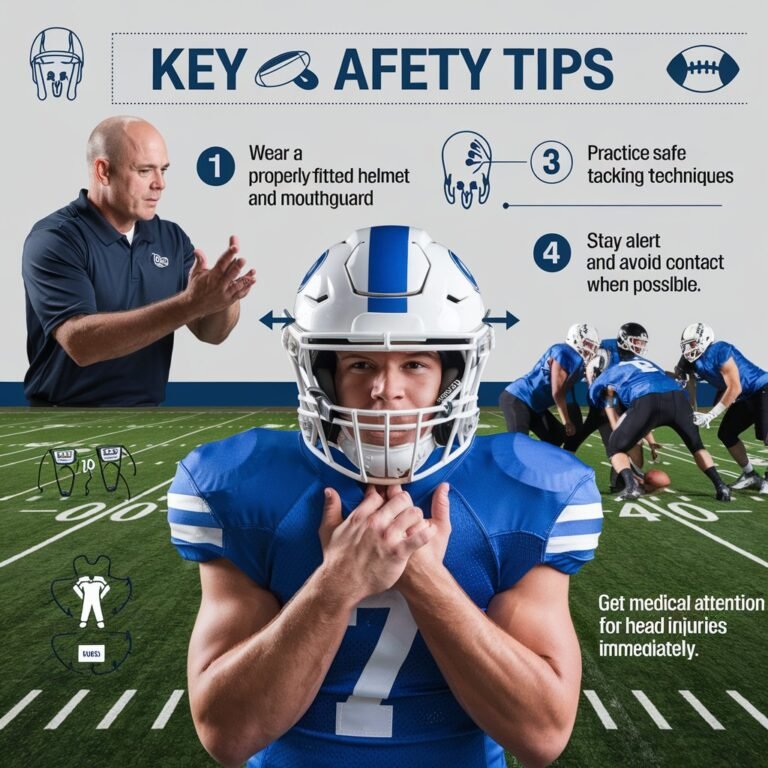Sports safety tips Whether you’re a professional athlete, a weekend warrior, or someone who simply enjoys a leisurely walk in the park, one thing is true: sports are an excellent way to stay healthy and active. However, just like any physical activity, they come with their own set of risks. The importance of sports safety cannot be overstated—protecting yourself from injuries allows you to continue enjoying the activities you love without setbacks. In this comprehensive guide, we will explore essential sports safety tips that will help you stay safe while keeping active.
Why Sports Safety Matters of Sports safety tips

Sports safety is not just about protecting your body; it’s about being smart and mindful of how you engage in physical activities. Injuries in sports can range from minor strains and sprains to more serious fractures and concussions. The good news? Many injuries are preventable with the right approach and mindset.
By practicing sports safety, you’re also encouraging better performance. When your body is healthy and functioning optimally, you can push your limits, improve your skills, and avoid common pitfalls. Plus, staying safe helps ensure that you can enjoy a long and injury-free athletic career—whether that means playing in a league, training for a marathon, or simply participating in casual sports activities.
In this post, we’ll dive into actionable sports safety tips that can be applied to virtually any sport. Let’s break them down!
1. Always Warm Up and Cool Down
A proper warm-up prepares your body for the physical demands of exercise. Jumping straight into strenuous activity without warming up can increase your risk of injury. On the flip side, cooling down after physical activity helps your body return to its normal state and reduces muscle stiffness.
Warm-Up Tips:
- Start with light cardio, like brisk walking or jogging, to increase your heart rate.
- Focus on dynamic stretches that move your muscles through their full range of motion. For example, leg swings, arm circles, or torso twists.
- Target the muscle groups you’ll be using in your sport (e.g., hamstring stretches for runners, shoulder stretches for swimmers).
Cool-Down Tips:
- Gradually decrease the intensity of your exercise to allow your heart rate to return to normal.
- Stretch major muscle groups, holding each stretch for 20-30 seconds to help relax your muscles.
Remember, both warm-ups and cool-downs prevent muscle strains, improve flexibility, and promote quicker recovery.
2. Stay Hydrated
Dehydration is a common culprit behind many sports injuries. When you’re dehydrated, your body cannot perform at its best. Dehydration increases your risk of cramps, dizziness, fatigue, and heat stroke, especially when you’re exercising in hot weather.
Hydration Tips:
- Drink water before, during, and after physical activity.
- For intense exercise lasting longer than an hour, consider using sports drinks that replace electrolytes.
- If you’re playing sports in the heat, take frequent breaks to drink water and cool down in the shade.
By staying hydrated, you’ll maintain peak performance and reduce the risk of fatigue-related injuries.
3. Use the Right Equipment of Sports safety tips
Wearing the correct gear for your sport is critical to prevent injuries. Whether it’s the right pair of shoes, helmet, or pads, appropriate equipment can make all the difference.
Equipment Tips:
- Shoes: Wear shoes that are designed specifically for the sport you’re engaging in. For example, running shoes for runners, cleats for soccer players, or cross-trainers for gym-goers.
- Protective Gear: Helmets, knee pads, elbow pads, and mouthguards are essential in contact sports like football, hockey, and biking.
- Clothing: Opt for moisture-wicking clothing to keep your body temperature regulated and reduce the risk of chafing.
Using the right equipment ensures you’re well-protected from injuries like sprains, fractures, and concussions.
4. Pay Attention to Your Body’s Signals
Listen to your body—it will often tell you when something isn’t right. Pushing through pain can lead to serious injuries, so it’s essential to recognize when it’s time to rest and recover.
Body Awareness Tips:
- Pain: If you experience sharp or persistent pain, stop immediately. Continuing to play can worsen the injury.
- Fatigue: When you’re tired, your body is more prone to accidents. Take breaks when needed and don’t push yourself too hard.
- Rest: Adequate rest is essential for muscle recovery. Ensure you’re getting enough sleep and taking days off to allow your muscles to repair.
Recognizing early signs of discomfort and taking appropriate action will help prevent more serious issues from arising.
5. Improve Your Strength and Flexibility
Strength and flexibility are the foundations of injury prevention. Strong muscles help stabilize your joints, while flexibility allows your muscles to move freely without strain.
Strength Training Tips:
- Include strength training exercises in your weekly routine, focusing on the core, legs, and upper body. These muscle groups are key for most sports.
- Perform bodyweight exercises like squats, lunges, and push-ups, or use weights to enhance your strength.
Flexibility Tips:
- Practice yoga or incorporate stretching exercises to improve flexibility and balance.
- Stretch regularly, not just after workouts, but also on rest days to maintain flexibility.
Stronger and more flexible muscles are less likely to get injured during intense physical activity.
6. Know the Rules of the Game of Sports safety tips
Injuries in sports often happen when players don’t fully understand the rules or play recklessly. Ensuring that you know the guidelines of the sport you’re participating in, and adhere to them, is crucial for your safety and the safety of others.
Rule Awareness Tips:
- Educate yourself on both the basic and advanced rules of the sport.
- In team sports, communicate effectively with your teammates to avoid collisions and dangerous plays.
- Practice good sportsmanship—being aggressive is one thing, but reckless behavior on the field can lead to avoidable injuries.
Being familiar with the rules helps you make smarter decisions and reduces the risk of accidents during the game.
7. Practice Injury Prevention Techniques
Sports injuries can be prevented with proper technique and awareness. Whether it’s learning the right way to tackle or ensuring you’re using the proper form during a lift, understanding injury prevention methods can go a long way.
Injury Prevention Tips:
- Proper Technique: Take the time to learn and master the correct form for every sport you engage in. This is especially important in high-impact sports like football, basketball, and weightlifting.
- Take Breaks: Overuse injuries can occur when you don’t allow your body enough time to rest between activities. Avoid overtraining by scheduling regular rest periods.
- Cross-Training: Mix up your routine by participating in different sports or activities. This helps reduce the risk of overuse injuries caused by repetitive movements.
By incorporating these practices into your routine, you’ll reduce the chances of an injury and maintain better overall health.
8. Be Mindful of Weather Conditions
Weather conditions can significantly impact your safety during sports activities. Extreme temperatures, humidity, and rain all increase the risk of injury.
Weather Safety Tips:
- Hot Weather: Avoid intense physical activity during the hottest parts of the day. Wear light clothing, use sunscreen, and stay hydrated to prevent heatstroke.
- Cold Weather: Cold temperatures can lead to muscle stiffness and increased injury risk. Dress in layers, warm up properly, and avoid overexertion.
- Rainy Conditions: Wet surfaces can be slippery and increase the likelihood of falls. Choose the right footwear and be extra cautious in wet conditions.
Staying aware of the weather can help you make safer choices and avoid preventable injuries.
9. Rest and Recover of Sports safety tips
Recovery is just as important as the physical activity itself. In fact, many athletes consider recovery to be just as important as training. Your muscles need time to heal and rebuild after intense physical activity.
Recovery Tips:
- Get plenty of sleep, as it’s when your body repairs itself.
- Consider techniques like foam rolling or massage to release muscle tension.
- Use ice packs for inflammation or swelling, and apply heat for sore muscles.
Taking recovery seriously helps you bounce back quicker and prevents the long-term effects of overtraining.
10. Seek Professional Guidance of Sports safety tips

If you’re serious about a sport, consider seeking professional guidance, whether it’s a coach, trainer, or physical therapist. They can provide tailored advice, help you improve your performance, and guide you in injury prevention techniques.
Professional Help Tips:
- A coach can teach you sport-specific skills and ensure you’re practicing safely.
- A physical therapist can assess your movement and help prevent injury by addressing any muscle imbalances or weaknesses.
- Trainers can guide you through effective workout plans and ensure you’re using proper techniques.
Getting expert advice can ensure you’re performing at your best while staying safe.
Conclusion
Staying safe while participating in sports should be a top priority for everyone—athletes of all skill levels. Whether you’re playing recreationally or professionally, the tips we’ve shared today can help you minimize your risk of injury. From warming up to listening to your body and using the right equipment, every step you take toward practicing sports safety adds up to a longer, healthier, and more enjoyable sports experience.









